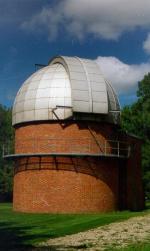| Warner and Swasey Observatory |
| Case Western Reserve University | Nassau Station |
| Visitors |
|
» Home » News » Gallery » Reference » Weather |
| Science Resources |
|
» NSRT User Interface » Software » Data Archive » Download Data |

|
 |

The Harvard classification scheme, which was developed at the very beginning of this century, classifies stars according to their spectral types. A spectrum is a range of electromagnetic radiation that is characteristic of a particular object. The sequence goes from type O stars (hot blue stars) to type M stars (cool red stars). The entire sequence is O B A F G K M ("Oh Be A Fine Girl/Guy, Kiss Me").
| Spectral Characteristics | |||
|---|---|---|---|
| Spectral Type | Characteristics | ||
| O | Hottest; Blue-white; Strong He II absorption lines | ||
| B | Hot; Blue-white; B2 has strongest He I absorption line | ||
| A | White; Balmer lines becoming weaker; Ca II lines becoming stronger | ||
| F | Yellow-white; Ca II stronger; Balmer weaker | ||
| G | Yellow; Ca II and Fe I becoming stronger | ||
| K | Cool; Orange; Ca II and K strongest at K0 | ||
| M | Coolest; Red; Neutral metal lines are strong; TiO band | ||
Since stars of different temperatures emit different colors of light (according to Wien's Law), and since different elements have characteristic spectra, a lot can be learned about a star by just examining it, and its spectrum.
It was noticed that not all stars of the same color can be classified in the same categories. The determination that truly seperates the regular old stars from the giants is their mass. Giants have much more mass than normal stars, although they are also much less dense (which means that they are even larger than they are massive). The Morgan-Keenan system classifies stars by their luminosity classes.
| Luminosity Classes | |||
|---|---|---|---|
| Class | Type of Star | ||
| Ia-O | Very luminous supergiants; Extreme | ||
| Ia | Luminous supergiants | ||
| Ib | Not as luminous supergiants | ||
| II | Bright giant stars | ||
| III | Giant stars | ||
| IV | Subgiants stars | ||
| V | Main sequence stars (dwarfs) | ||
| VI, sd | Subdwarfs | ||
| D | White dwarfs | ||
For example, our Sun is a G2 V star, while a red supergiant like Betelgeuse is a M2 Ia star.
Wien's Law: a relationship between the temperature of an object, and the characteristic wavelength of electro-magnetic radiation that it emits.

Remember that longer wavelengths mean lower frequencies, and therefore lower energies. Lower energy means lower temperature. Check out this cool java aplet to better understand how this displacement takes place.
Look at the spectra of real stars
Back to Stars Page
Created by Marta Lewandowska, July 1999.
©1999 CWRU Astronomy Dept.
comments
Last modified July 1999
Case Western Reserve University